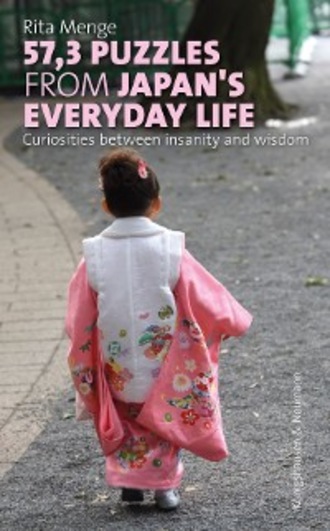
Полная версия
57,3 puzzles from Japan's everyday life
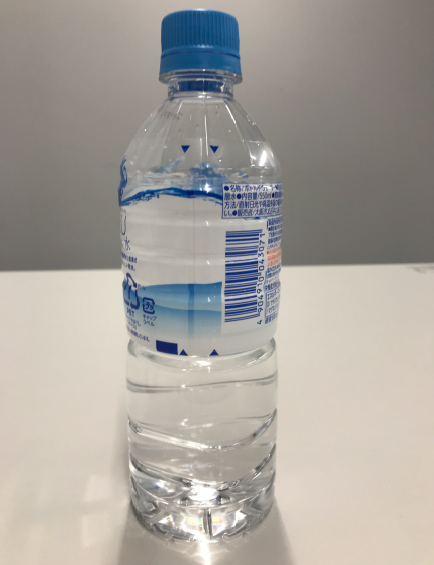
What is the meaning of the little blue arrows on this water bottle?
At this spot, marked by the blue arrows, you open the plastic label to bring it together with the lid to the plastic waste, the bottle is then sorted separately.
Waste separation is unsexy and annoying! That's what I thought too, until I learned to separate garbage in the Japanese way. You might just have to do it with a little mantra on your lips and the idea of a cute garbage mascot and it is getting easier and I became a dedicated garbage separator in Japan. Mostly I have my own shopping bag, which often causes a surprise for supermarket cashiers.
The subject of garbage is an extremely difficult one in Japan and hardly anyone seems to completely understand it. In households in Tokyo, a distinction is made whether the garbage can be recycled or not. There are complicated rules here. The bag in which the fruit was packed, is certainly recyclable, but what about plastic sheeting? When I cut off the plastic window of the envelope, where does it belong-recyclable or residual garbage?
But if you keep looking at it and keep in mind the leaflets available in every household, you find that it all makes sense. Only if the garbage is cleaned and carefully separated a high rate of recycling can be realized. You cannot recycle a jar of moldy jam or a greasy pizza box. In companies, there are up to twelve different containers for garbage. For example, paper is differentiated, whether and how it is printed.
In the case of gross violations of waste separation, a photo might even be taken and attached to the bulletin board in residential units, mentioning the floor and the date.
Foreign visitors are always struck by the fact that there are virtually no trashcans on the streets and train stations. However, this is not due to the complicated separation of waste, but on the one hand Japanese authorities do not want to spend any tax money on the disposal of individual waste and on the other hand Japan does not want to offer any possible hiding places for criminal acts since the poison gas attack in 1995. The Japanese have become accustomed to it and do not simply throw their garbage into the street, but take it home to throw it away.
The good news is that a lot of waste is being recycled in Japan, and the return rate for beverage cans is 95%.
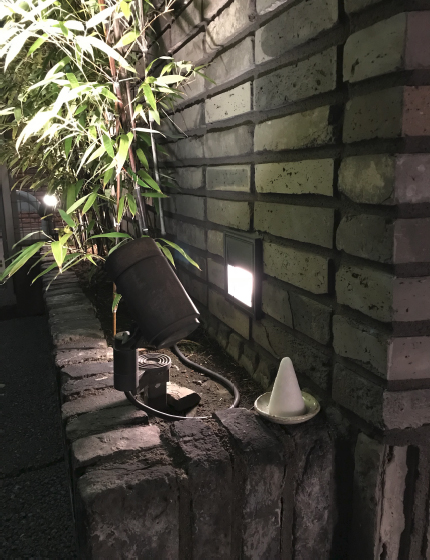
What is the meaning of this white cone in front of a restaurant?
This is a heap of salt. Such small salt formations can often be seen in front of Japanese restaurants and are supposed to protect from evil spirits.
What should salt be good for, apart from flavoring food or to fight icy surfaces in winter? In Japan it cannot hurt to throw a little salt or set it up. If you notice that a Japanese people are suddenly spreading salt in or in front of their apartment, it means that an unpleasant person was present.
Salt always had a special meaning in Japanese culture, which is certainly due to its elaborate extraction. Salt plays a role in many rituals, traditions and customs. Additionally, it still has great significance in modern urban life.
If you walk through Japanese cities, you can always see these little salt cones at entrances. The meaning is manifold, because you can regard the salt as a good luck charm or as protection from evil spirits.
Furthermore, the salt cone shows customers that this restaurant values cleanliness and tradition. The effort to exchange the salt every day and bring it into the shape of the cone also illustrates that there is a lot of emphasis put on running the business well. Another conjecture for setting salt or painting the door sill with salt is that in the past, restaurants and shops wanted to attract the horses of travelers with as horses like to lick salty objects.
Nowadays, salt is still used to ritually clean the visitors after a burial ceremony and to ensure that no sinister things are brought into the house.
If you are a fan of the Japanese wrestling Sumo, you know about cleaning the battle ring with salt. The fighters throw salt to the ground directly after entering the ring, thereby they evict the evil and the soil is cleaned. In addition, it also asks the gods for protection against injury.
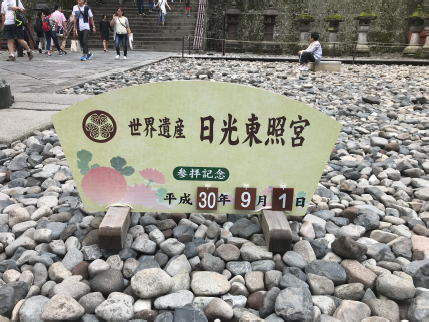
Which date does this sign show?
This sign shows the date of September 1, 2018. The number 30 on the far left states the year of the reign of the current Emperor and 2018 is here the year 30.
In Japan it is discussed again and again, whether they should dare the courageous step to also change to the western calender in official documents. Unrest among the population, such as the mid-19th century, when the Gregorian calendar was introduced, is unlikely to be feared, but today those responsible may fear a virtual storm of protest.
Since 1872, the Japanese have been using the Gregorian calendar, which superseded the hitherto accepted lunar system adopted from China. However, there are still many special features in dealing with the date today. On many official documents, for instance Bank documents, driving licenses or postal documents the year of the corresponding imperial year is used, which indicates how long the respective emperor sat on the throne this year. As these reigns naturally change relatively often, the official name of the Tenno Period is added as an addition, e.g. 2018 is the name of the Tenno Period Heisei, which began in 1989 and 2018 identifies the year 30. The era before that was Showa: 1926-1989, 1930 is then in Japanese Showa 5.
But this is not the only special feature. In Japan, besides the seven-day week, people also use the Chinese lunar calendar. This calendar includes special lucky and unlucky days, the worst day is the Butsumetsu. You should not do anything important on this day. The best day is the Taian, which promises great security and peace. This is the perfect day for all important things, such as a wedding. It gets really complicated on the other four days, it depends on the time of day, whether you should do something important or not. For example, the Shakkou is a rather unlucky day, except between 11:00am and 1:00pm.
To put it simply, the modern day Japanese treatment of the six-day week is comparable to the fear that Friday's thirteenth could bring bad luck. However, as these old names are still listed in almost all calendars, perhaps many Japanese take these prophecies more seriously than they would like to admit to themselves and others. Also the modern person thinks: just in case. In Germany everyone knows that it brings misfortune to congratulate too early for birthdays or New Year.
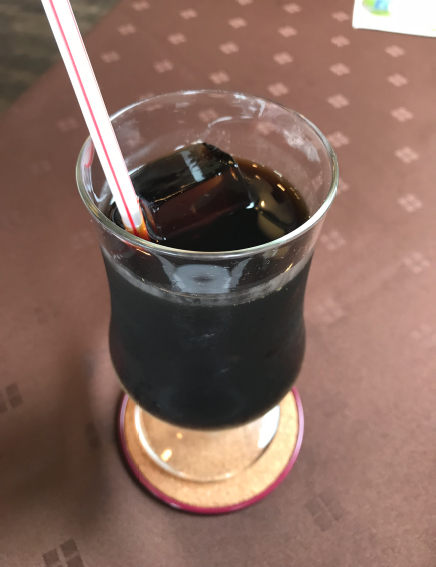
What kind of drink is in this glass?
This is ice cold coffee, which Japanese usually drink with ice cubes, syrup and milk.
In a coffee shop in Tokyo, at 5°C outside temperature: „May I have a coffee." "Would you like it hot or cold?" Confusion in the foreigner's face gets followed by a reflection and the annoyed answer: "Hot of course, I am foreign". Although many trends in Japanese cuisine have prevailed in the West, cold coffee is more suitable for watering pot plants than drinking.
Until the mid-nineties Japan was still a nation of tea drinkers. It was difficult to even get a coffee. The place was mostly a dark cellar restaurant, the coffee tasted strange and cost a small fortune. Even in the Shibuya district, there were only two tiny coffee shops. Suddenly the situation changed, practically overnight, but what had happened? The American chain Starbucks had their start in the Japanese islands in 1996, and the coffee shops quickly became popular places to meet friends or wait for a business meeting. The Japanese companies also wanted to participate in this success story and suddenly there was Japanese competition for Starbucks and practically at every street corner a pleasant café with tasty drinks and small snacks opened. The best-known Japanese chains are Pronto, Excelsior Caffé, Doutor, Tully's Coffee and many smaller companies. But Starbucks owns by far the largest number of coffee shops in Japan, with 1363 stores. In Germany in 2016 there were only 158 locations.
Конец ознакомительного фрагмента.
Текст предоставлен ООО «ЛитРес».
Прочитайте эту книгу целиком, купив полную легальную версию на ЛитРес.
Безопасно оплатить книгу можно банковской картой Visa, MasterCard, Maestro, со счета мобильного телефона, с платежного терминала, в салоне МТС или Связной, через PayPal, WebMoney, Яндекс.Деньги, QIWI Кошелек, бонусными картами или другим удобным Вам способом.



